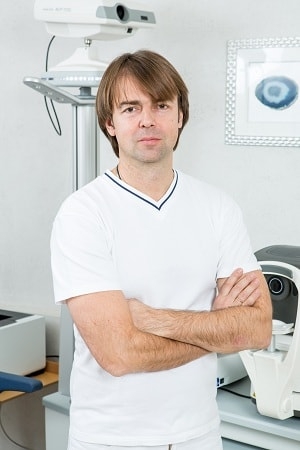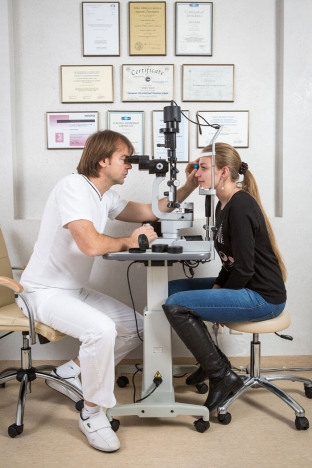Patient health – it is always a joint result of the work of doctors of various specialties. But the connection of the patient's ophthalmological problems with diseases, say, of the joints or the endocrinological system, is not always traced clearly enough. However, there are many factors that rheumatologists, endocrinologists, pediatricians and other doctors should be on the lookout for, since severe visual problems in patients can become a complication of a number of diseases.
 The head of the ophthalmology department of the Medical Club Andrey Nikolaevich Ruban, doctor of the highest category, told Estet-portal.com readers about what factors should be the reason for referring the patient for a consultation with an ophthalmologist, Candidate of Medical Sciences, Member of the European Society of Vitreoretinal Surgeons (EVRS) and the European Retinal Society (EURETINA).
The head of the ophthalmology department of the Medical Club Andrey Nikolaevich Ruban, doctor of the highest category, told Estet-portal.com readers about what factors should be the reason for referring the patient for a consultation with an ophthalmologist, Candidate of Medical Sciences, Member of the European Society of Vitreoretinal Surgeons (EVRS) and the European Retinal Society (EURETINA).
– What signs of eye diseases should other doctors be aware of in order to prevent vision complications in their patients?
– First of all, I would like to recall such a serious and formidable problem as diabetes mellitus (DM). Unfortunately, the number of patients with diabetes is steadily increasing. So, according to the International Diabetes Federation (IDF), there are & nbsp; 390 million patients with diabetes. By 2025, according to experts, their number will increase by 55%. About 1.5 million patients with diabetes mellitus are officially registered in Ukraine, although the actual incidence is much higher. Each patient with diabetes mellitus, 10 years after the onset of the disease, has a high probability of developing such a severe complication as diabetic retinopathy (DR), which affects the retina of the eye and can lead to complete blindness.
Early diagnosis of diabetic retinopathy and timely treatment reduces the rate of disease progression and the risk of vision loss. However, it should be borne in mind that in the early stages of the disease, symptoms are not observed, so timely diagnosis of the disease is difficult. The way out is the active screening of patients with diabetes in specialized & nbsp; ophthalmological centers. According to modern international recommendations, the first examination by an ophthalmologist & nbsp; held:
- Adult patients with type 1 diabetes– 5 years after the discovery of DM and then every year;
- Adult patients with type 2 diabetes – immediately after diagnosing DM and every year thereafter;
- pregnant women with diabetes before pregnancy – at the planning stage and every trimester thereafter.
Therapists, rheumatologists also quite often contact patients who may later have serious vision problems. These are most often young patients with juvenile arthritis who have severe inflammatory eye diseases.
Of course, I would like to recall such a problem as retinopathy of prematurity. And although our Center does not deal with pediatric ophthalmology, I would like to remind neonatologists, pediatricians about the very high probability of such children to have vision problems and the need for a routine examination by an ophthalmologist.

And, of course, the development of civilization, the extensive use of modern technologies, computer systems, and various gadgets leads to the fact that almost all young people enter & nbsp; at risk for the development of computer visual syndrome and induced myopia. Therefore, a pediatrician, and indeed any doctor who is related to patients of the teenage group, should also focus on the fact that a preventive examination by an ophthalmologist will help maintain high vision for life.
– Do you think that computer technology affects the development of myopia ?
– This is a rather difficult question. Rather, it is not so much computer technology as excessive strain on the organ of vision in young people with visual load near. Excessive visual load leads to & nbsp; a whole complex of factors, which includes an increase in eye pressure, and squeezing the eyeball with eye muscles, and tension in the intraocular muscles, which contribute to the fact that a teenager may develop myopia.
In order to prevent this, it is important to observe a regimen of dosed visual load near, it is necessary, no matter how trite it may sound, walks in the fresh air and a harmonious combination of both visual load and physical activity. And of course, if there is already myopia, then professional spectacle or contact correction is necessary.
And yet, this problem of teenage myopia is not only medical, but also social, because, in those countries where young people use computer technology excessively, as a rule, there is fierce competition, and people from childhood are determined to read a lot, study in order to achieve something in life and win certain positions. In such countries, the number of patients with myopia can reach 90% of the population. This is, first of all, the Asian region - South Korea, Japan. We still have fewer such patients, but a similar & nbsp; the trend, unfortunately, exists.
– Tell me, are there any rules of conduct for expectant mothers if they have vision problems?
– There are a number of genetically determined eye diseases that are inherited, but, fortunately, they are quite rare. If the expectant mother still has a hereditary retinal lesion, then it is advisable to consult a geneticist before planning pregnancy. Unfortunately, doctors are not yet able to prevent the development of genetically determined eye diseases, but the first results & nbsp; application of technology genetic engineering allows you to look optimistically into the future.
As for the inheritance of myopia, the probability of giving birth to a myopic child in healthy parents is less than 10%, but if both parents are myopic, then this probability increases to 50%. A lot of pregnant women, & nbsp; with myopia and peripheral retinal dystrophy are concerned that natural childbirth is contraindicated for them and it is necessary to do a caesarean section. Today, in all civilized countries, it is generally recognized that there are no ophthalmic indications for choosing a method of delivery. Therefore, we can say with confidence that all future mothers who have problems with the retina (if there are no other obstetric contraindications) can give birth naturally, since this is a natural physiological process that is important for both the child and the mother.
As for the prevention of eye diseases in a child, the normal course of pregnancy, the prevention of typical risk factors that may affect the unborn child – avoidance of teratogenic factors, smoking, exposure to harmful chemicals - all this will contribute to the birth of a normal healthy child.
Make an appointment by phone: +38 (044) 499-70-00 | +38 (044) 499-70-07







Add a comment